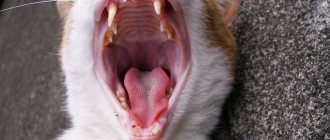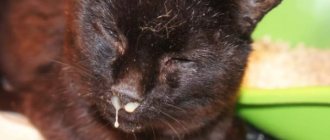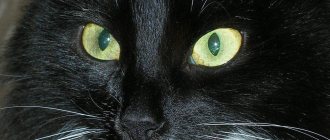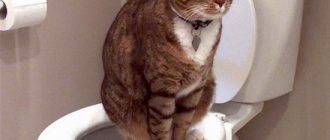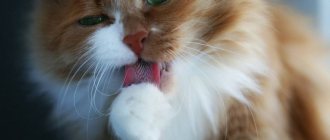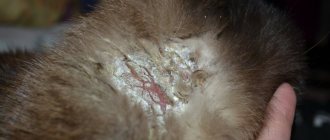The appearance of discharge from under a cat's tail should not go unnoticed by the owner. The appearance of blood in the area of the tail root may indicate the beginning of a pathological process in the body, or be a sign of incipient estrus.
It is important to promptly detect other characteristic symptoms, observe the general condition and behavior of the animal, and also contact a veterinarian for an accurate diagnosis of what is happening. It is quite problematic to independently identify the cause of blood discharge from under the tail, and self-medication is absolutely unacceptable.
Poor quality feed
Economy segment feeds cause serious harm to the gastrointestinal tract of the animal. The result of using low-quality feed can be vomiting and constipation in the animal, problems with the liver and gall bladder, and blood from the cat’s anus. To avoid such problems, you should buy only expensive, high-quality food recommended by veterinarians. Water should be freely available to the animal. Sometimes the diet should be diluted with wet food from the same company as dry food.
You should be careful when feeding natural food. Raw fish and meat can lead to parasite infestation. Constant feeding of fish leads to problems with the liver and gall bladder, which later affects the intestines. Many owners feed their cats tubular chicken bones. This should not be done under any circumstances! Chicken bone fragments are very sharp, they can easily rip a cat's throat. In addition, they can accumulate in the stomach and injure it or damage the intestines. When feeding natural food, it is important to properly balance the diet. It should contain meat and grains, and the cat should also receive vitamin and mineral supplements.
Therapeutic techniques
If your cat becomes dehydrated from chronic diarrhea, she will need to be hospitalized for intravenous rehydration. When the inflammation is particularly severe, the animal must be put on a starvation diet for 24-48 hours, since the rectum needs time to restore the epithelial layer.
The owner must provide the sick pet with a suitable diet containing a sufficient amount of dietary fiber. In ideal cases, the pet is fed special protein foods specifically designed for such cases. Adding bran to your food may be helpful. They improve digestion, enhance peristalsis, as a result of which the colon begins to better absorb water. This prevents the cat from becoming dehydrated. Just don’t overdo it, as these components can irritate the intestinal mucosa.
The list of prescribed drugs will depend on the root cause of inflammation. For example, for helminthic diseases, anthelmintic drugs are used, but it must be taken into account that a weakened animal’s body should not be “injured” by means that have a negative effect on the liver. Anti-inflammatory and immunosuppressant medications may be prescribed if an autoimmune reaction is the cause. Some types of colitis do not respond well to drug treatment: in these cases, surgery may again be required.
Meanwhile, if chronic inflammation and scar tissue have formed in the colon, such simple techniques will no longer help. A surgical operation will be required, during which the affected areas of the organ will be cut out. It should be noted that with proctitis of fungal etiology, surgery is most often required, since pathogenic fungi greatly destroy the tissue of the affected organ.
Constipation and bowel diseases
Including improper feeding can cause constipation in a cat. If the stool is too dry and the animal struggles to push it out, damage to the intestinal wall can occur. In this case, you can observe blood from the cat’s anus and in the feces. There can be many reasons for constipation. It is important that the animal eats properly and gets enough fluids. If constipation constantly torments your pet, it needs to be shown to a doctor.
Another cause of bleeding from the anus in a cat can be hemorrhoids. This disease is rare in cats, but it can lead to the death of the animal. With hemorrhoids, you may notice slight inflammation and redness in the anal area. Gradually it increases in size. Hemorrhoids can cause excessive bleeding, which can lead to death. It can be treated with special ointments and suppositories, and in the most advanced cases it is necessary to undergo surgery to remove it.
Sometimes blood flows from a cat's anus due to inflammation of the anal glands. The animal needs them to mark territory and lubricate feces. If the glands become clogged, suppuration occurs in them. In this case, bleeding is possible. For treatment, the anal glands must be cleared of pus. Only a doctor can cope with this.
Causes of anal bleeding
Blood under the tail in cats appears for the following reasons:
- haemorrhoids;
- anal fissure;
- inflammation of the paraanal glands;
- anticoagulant poisoning;
- isosporosis;
- tumors.
Clinical signs, methods of eliminating the problem, and methods of prevention are not the same. Therefore, each disease is reported in a special section.
Parasites
If your cat is bleeding from the anus, the cause may be helminths. They are especially dangerous for street animals. Infection can occur from other animals or through food. You should not give cats fish and meat that have not been heat-treated. In order to prevent infection, periodic deworming should be carried out. Cats that are kept without walking should also be subjected to it. Anthelmintic drugs are not able to cope with all possible parasites. If they do not help, you need to get tested to identify the parasite. After diagnosis, the doctor will prescribe suitable treatment.
Vaginal mucus
Thick mucus from the vagina, which is secreted in yellowish clots, occurs after unprotected sex. After a few hours, this discharge is liquid and white in large quantities.
If mucus streaked with blood is released from the vagina at the end of the menstrual cycle, then this is a harbinger of the onset of menstruation.
Mucus in various diseases can change color (from brown to greenish), it may have an unpleasant odor, the discharge can cause itching or irritation of the genital tract, and contain impurities of pus or blood.
The most dangerous thing is the appearance of blood along with mucous secretions, for example during pregnancy this indicates detachment of the fertilized egg or miscarriage. Even brown discharge or clots without fresh blood may indicate a threatened miscarriage or fetal death.
Before menstruation or after sexual intercourse, such discharge indicates erosion of the cervix (usually there is little blood, only streaks in a large amount of mucus).
Very characteristic mucus discharge, which resembles cottage cheese and causes itching and irritation of the genital tract, with a sour odor, occurs with candidiasis (thrush).
In inflammatory diseases, the discharge is yellowish or greenish, reminiscent of purulent discharge, often with an unpleasant odor.
In oncological diseases with decay, the discharge is mucous, bloody and purulent with clots, sometimes with a very unpleasant odor.
Dimexide solutions are widely used in medicine and cosmetology as an anti-inflammatory agent. In gynecology, its use is also justified. We will tell you how to properly make a vaginal tampon with Dimexide.
Rectovaginal fistula is a rare postoperative complication that requires immediate surgical intervention. What kind of pathology is this, how it is expressed and why it is dangerous, you will learn from our article.
If vaginal discharge is
Source
Infections
Some infectious diseases can cause bleeding from a cat's anus. Most often they are accompanied by high body temperature, lethargy and refusal to eat, cough, and drowsiness. Bacterial infections are very dangerous for the animal and can be fatal. To accurately determine the cause of your pet’s illness, you must show it to a doctor. Depending on the diagnosis, the cat may be prescribed antibiotics. During treatment, the animal is given vitamins and medications that support the immune system.
Thus, we have listed the main causes of blood from a cat’s anus. Only a doctor can determine exactly why this happens. If you notice bloody discharge from the anus or blood in the animal's stool, the cat should be taken to the vet immediately.
Diagnostic methods
To make a correct diagnosis, it is important to describe the pet’s condition to the specialist as accurately as possible, list all existing abnormalities and past illnesses. The veterinarian may be interested in the following points:
- how often does a cat walk with a lot of blood;
- Does your pet show anxiety when defecating?
- how much blood is released, what is its thickness and color;
- whether there are other foreign matter in the stool;
- has the animal’s appetite changed or thirst increased;
- is there nausea, diarrhea;
- whether there was an increase in body temperature.
Therapy is prescribed only after passing the necessary tests. As a rule, the following manipulations are required:
- Colonoscopy. Using endoscopic examination of the intestine, you can detect erosions on the mucous membrane of the organ, as well as ensure the absence of neoplasms and foreign bodies.
- X-ray. Studying the image allows you to diagnose acute intestinal obstruction, as well as study in detail the volumetric neoplasms.
- Coprogram. The concentration of red blood cells, white blood cells, mucus and undigested food in the cat’s feces is determined.
- A blood test, the results of which may show signs of anemia, dehydration, and leukocytosis.
- Stool analysis for parasites and occult blood.
- Examination of urine samples in laboratory conditions.
How to treat?
Your doctor will help you choose a treatment method.
The treatment regimen consists of mechanically squeezing out excess fluid. In case of severe and severe pain, they resort to injections of antibiotics with novocaine. The course of antimicrobial therapy should not be less than 7 days.
In particularly difficult cases, you have to resort to washing the bags with special solutions - this procedure is done, naturally, in a clinic by a professional. If an abscess occurs, they resort to opening it and subsequent treatment of the purulent wound.
If the process takes a chronic form and the animal has to clean the anal glands too often, then it is best to remove them altogether, since they do not carry a serious functional load.
In any case, the choice is always up to the veterinarian; only he, based on his own experience, will be able to make the only correct decision.
Washing
This procedure can only be performed by a specialist. It is indicated for significant inflammation, when there is suppuration and a through hole is formed.
It is important to know that treatment at this stage will take a long time, and recovery is not guaranteed. You will have to resort to the procedure constantly in order to at least slightly reduce the animal’s pain.
Washing consists of the following steps:
- preparing and filling an antiseptic solution into a syringe;
- pouring liquid into the hole;
- repeat the procedure until the clearest liquid flows out;
- treatment with an antimicrobial agent.
To prevent the cat from licking itself, a collar, diaper or blanket is put on it.
Treatment
As a rule, treatment of diarrhea in cats is carried out at home. For this purpose, complex therapy is prescribed, which includes:
- Taking antibacterial agents . If a kitten has diarrhea with blood, suspensions of Enterofuril, Stopdiar, Diarcan are used. They do not disrupt the intestinal microflora and are active against a wide range of bacteria. Prescribed three times a day for a course of 3 to 10 days with a single dose of 0.5 ml. For adult cats, the dosage is 2.5 ml. Adult pets are also prescribed Levomycetin with a single dose of ¼ tablet 3 times a day for a week.
- Taking probiotics , which help restore intestinal microflora (Bifidumbacterin). The powder is dissolved in a fermented milk drink and administered in 5 doses to an adult cat; for kittens, the dosage is halved.
- Taking sorbents to remove toxins and improve general condition (Smecta, Enterosgel, Activated carbon). The latter drug is not used to treat loose stools in a kitten. The dosage for an adult cat is 5 ml (g), for small cats - 1-2 ml. Sorbents are introduced into the animal’s mouth every 2-3 hours.
- Taking deworming medications (Envir, Drontal, Prazicide). It is prescribed in a dosage of 5 mg of the active substance, which corresponds to 1 tablet for every 4 kg of the pet’s weight. Do not use if there is blood in the diarrhea of a kitten under 3 weeks old.
- Taking rehydration solutions to restore water and electrolyte balance (Regidron, Gastrolit).
Warning
It is advisable to carry out mechanical cleansing by a veterinarian, especially if you are not confident in your abilities. Staining your apartment or yourself with a fetid odor is still half the problem. Problems may arise during the manipulations themselves:
- experiencing discomfort, fear and pain, animals do not always behave adequately, which can result in serious injury to the “home-grown surgeon”;
- In addition, around the anus there are a large number of nerve plexuses and blood vessels, the trauma of which through inept actions can end disastrously for the health of the pet.
If you have an irresistible desire to do everything yourself or you need to resort to the procedure too often, then take the trouble to first take a master class from a professional, and then go ahead and act on your own.

